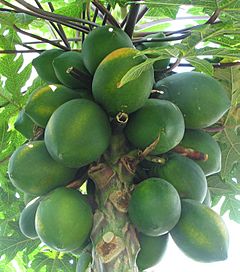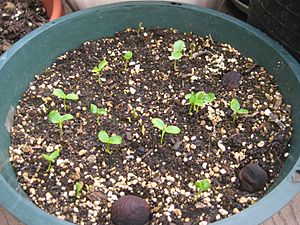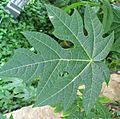Papaya facts for kids
Quick facts for kids Papaya |
|
|---|---|
 |
|
| Papaya trunk with immature fruit | |
| Scientific classification | |
| Kingdom: | |
| Division: | |
| Class: | |
| Order: | |
| Family: | |
| Genus: |
Carica
|
| Binomial name | |
| Carica papaya |
|
The papaya is a tall plant known for its delicious, edible fruit, also called papaya. It is a type of herbaceous plant, which means its stem is soft and green, not woody like a tree. Papayas originally come from the warm, tropical parts of America, especially southern Mexico and Central America. Today, you can find these plants growing in tropical areas all around the world.
Papaya plants need a warm climate to grow well and produce fruit. They cannot survive in cold temperatures. The Carica genus, which papaya belongs to, now only has one species: Carica papaya. Other species that used to be in this group have been moved to different plant groups after more research.
Contents
What is a Papaya?
How the Papaya Got Its Name
The name Carica was given by Carl Linnaeus, a famous scientist. He chose this name because the leaves of the papaya plant look a lot like the leaves of the common fig tree, which is called Ficus carica.
The common name "papaya" comes from the word papáia used by the Taíno people. This word was then changed into "papaya" in Spanish, and it is now used worldwide. In some places like Australia and parts of the Caribbean, people might call the fruit "papaw" or "pawpaw." However, another plant in North America, Asimina triloba, also shares this name.
Different countries have their own names for papaya. In French, the fruit is papaye, and the plant is papayer. In Portuguese, the fruit can be called mamão, papaia, or ababaia, while the tree is mamoeiro or papaeira. In Kerala, India, it is known as Kapanga (കപ്പങ്ങ). In Cuba, people often call it fruta bomba, except in the eastern areas where "papaya" is still used. In the Dominican Republic, parts of Venezuela, and eastern Central Colombia, it is known as lechosa. In Argentina and Paraguay, the fruit is called mamón.
You can find more names and translations for papaya at Wiktionary.
The Papaya Plant's Appearance
The papaya plant is quite large and can look like a tree, but it is a herbaceous plant. This means its stem is soft and green, not hard and woody. It usually grows without branches, with a single stem reaching 5 to 10 meters (about 16 to 33 feet) tall. All its large leaves, which are 50–70 centimeters (about 20–28 inches) wide, grow at the top of the stem.
Some papaya plants have "perfect" flowers, meaning they have both male and female parts. Other plants have flowers with only one sex, either male or female.
The Papaya Fruit
The papaya fruit is usually oval or nearly round, sometimes shaped like a large pear. Fruits can be 15-50 cm (about 6-20 inches) long and 10–20 cm (about 4-8 inches) wide. Some can even weigh up to 9 kg (about 20 pounds)!
The fruit's skin is thin and tough, so it is not eaten because it is too bitter. When the fruit is young, its skin is green. As it ripens and gets ready to eat, the skin turns yellow. Inside a ripe papaya, the flesh can be yellow, orange, pink, or even light red. The center of the fruit is filled with many small, black seeds.
How Papaya is Used
Eating Papaya
Ripe papayas are often eaten fresh. First, you remove the skin and seeds. You can cut the fruit into small pieces and mix it with other fruits to make a fruit salad. Papayas that are not fully ripe can be cooked with sugar and eaten as a dessert. In tropical areas, it is very popular to make papaya juice. This juice can also be mixed with milk to create tasty smoothies.
Green papayas, which are not ripe, are used in some Asiatic countries. They are often added to salads, curries, and soups. However, they should be boiled before eating. Young papaya leaves and stems can also be cooked and eaten as a vegetable. Green papaya is a common ingredient in Thai cuisine, used both raw and cooked.
Health Benefits of Papaya
Papaya is a good source of important nutrients. It provides iron and calcium. It is also a good source of vitamins A, B, and Riboflavin. Papaya is an excellent source of vitamin C (ascorbic acid), which is important for your immune system.
Other Uses of Papaya
The latex (a milky sap) found in green papaya fruits, leaves, and stems is rich in something called papain. Papain is an enzyme that can break down tough meat fibers. Because of this, papain is used in products called "meat tenderizers," which you can buy in shops to make meat softer before you cook it.
Papaya seeds have a peppery taste. They can even be used as a substitute for black peppercorns in cooking!
Images for kids
See also
 In Spanish: Carica papaya para niños
In Spanish: Carica papaya para niños







